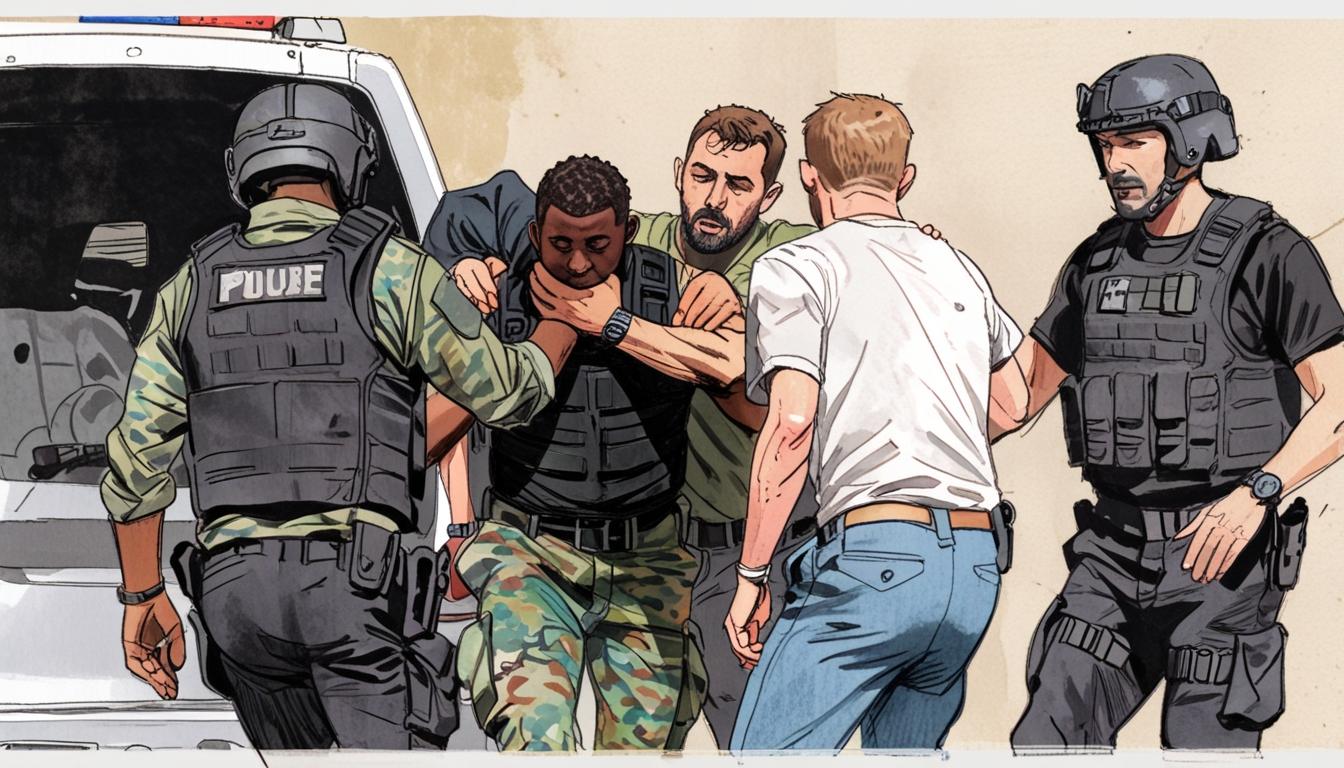The arrest of a 40-year-old Iranian asylum seeker in connection with a planned terror attack on the Israeli embassy in London has intensified concerns over migrant vetting processes and Iran’s use of migration routes to execute state-backed plots, highlighting urgent challenges in balancing national security with humanitarian asylum policies.
An asylum seeker from Iran has emerged as one of five men arrested in London for an alleged terror plot targeting the Israeli embassy, raising concerns about the intersection of immigration and national security. This dramatic development unfolded on May 3, when a 40-year-old Iranian, believed to have entered the UK illegally via small boats, was pulled from a taxpayer-funded home in Rochdale by armed police and Special Forces. His dramatic arrest, captured on social media, took place just hours before the alleged attack was to be executed.
The audacity of this plot highlights a broader trend of escalating Iranian-hosted threats against Israeli interests abroad. According to MI5, Iran is associated with at least 20 attempted terror plots in the UK alone since January 2022. The nature of the attacks has evolved in line with heightened geopolitical tensions. Experts warn of a trend where state-backed terror groups exploit migrants’ routes—a perception that could exacerbate the already contentious debate over asylum policy in Britain.
The 40-year-old’s living situation only amplifies the scrutiny on the asylum process. Residing in a Serco-managed property, the asylum seeker shared a home that typically accommodates multiple refugees without requiring them to pay rent or bills. Such arrangements, while providing accommodation to those fleeing danger, have raised concerns about who is entering the country under the guise of seeking sanctuary.
A former tenant of the same property noted that they had no interactions with the accused beyond casual greetings. This has prompted questions from neighbours and local authorities about the vetting processes in place for those housed in similar accommodations. Alarmingly, with Iran’s use of migrant routes to mask its operatives’ movements, the incident has ignited fears that other arrested individuals may also be asylum seekers who reached the UK under similar circumstances.
The increasing number of small-boat arrivals from Calais—over 11,000 this year alone—further complicates the scenario. Such numbers highlight the expanse of this issue, as Iranian nationals made up the third-largest group of migrants last year. This stark reality fuels the narrative convening around national security and immigration. Anthony Glees, a terrorism expert from Buckingham University, voiced concern, stating that the use of overly permissive migration routes could serve as conduits for hostile state actors. “A dedicated agent of a hostile state will use this route to come into the country,” he asserted.
Moreover, this incident is part of a broader tapestry of Iranian-directed threats that have emerged across the world. Recent reports indicate that Iranian nationals have been implicated in various plots extending from the Americas to Europe. Cases in Peru, where a suspected Quds Force member was arrested, underscore the extent of Iran’s operations beyond its borders. Similarly, intelligence services in Cyprus thwarted another Iranian plot to assassinate Israeli businessmen, with the suspected operatives being Iranian asylum seekers.
As other nations grapple with similar threats, the case serves as a troubling reminder of the security challenges faced in an increasingly interconnected world. The debate surrounding immigration, particularly for those entering through informal channels, will undoubtedly intensify as authorities strive to protect national interests while fulfilling humanitarian commitments.
Meanwhile, the interplay of immigration and national security continues to ignite heated discussions, with critics calling for stringent measures to prevent potential threats from entering the UK. Despite their apprehensions, official bodies like the Home Office and Serco have remained relatively silent on the matter, directing attention back to the overarching implications of these events.
As the investigations into this particular plot continue, the unfolding story serves as a critical juncture for UK policy on asylum, with broader implications for international relations and domestic security strategies.
Reference Map
- Paragraphs 1, 2, 3, 4, 5, 6
- Paragraphs 6, 7
- Paragraphs 6, 7
- Paragraph 6
- Paragraph 6
- Paragraph 6
- Paragraph 6
Source: Noah Wire Services
- https://www.dailymail.co.uk/news/article-14698995/Iranian-arrested-foiled-terror-plot-Israeli-embassy-asylum-seeker.html?ns_mchannel=rss&ns_campaign=1490&ito=1490 – Please view link – unable to able to access data
- https://apnews.com/article/b89d6b69b182feafb96b44cbdefa190a – A Peruvian judge ordered 18 months of preventative detention for Iranian national Majid Azizi and two Peruvians, Walter Loja and Ángelo Trucios, amid an investigation into an alleged plot to kill two Israelis residing in Peru. The ruling also included accusations of conspiracy to commit terrorism. Azizi is suspected by Peruvian authorities to be a member of Iran’s Quds Force. The Israeli embassy in Lima commended Peruvian law enforcement for thwarting the alleged attack, which targeted Shachar Malka and Gilad Duchovny. Items found in Azizi’s Lima residence linked him to the conspiracy, and Trucios has a criminal history. Azizi’s defense denies the allegations, citing his heart condition. This case marks the first arrest in Peru of a suspected Quds Force member, a group linked to intelligence activities in South America and previous attacks coordinated by Iran.
- https://www.reuters.com/investigations/murder-hire-inside-irans-proxy-war-with-israel-west-2024-10-05/ – The intensifying conflict between Iran and Israel has led to a rise in alleged assassination and kidnapping plots in the West by Iranian proxies since 2020. Reuters’ investigation found at least 33 such attempts linked to Iran, targeting Jewish centers, U.S. officials, and Iranian dissidents. One notable case includes a 2023 plot to attack a Jewish center in Athens, orchestrated by Sayed Fakhar Abbas from Iran, using Pakistani recruits. Greek authorities dismantled the network, charging the suspects with terrorism-related crimes, while Israeli intelligence, Mossad, attributed the orchestration to Iran. Iran denies involvement, accusing its adversaries of similar acts. This shadow war reflects the broader geopolitical tensions, with both nations exchanging accusations and retaliatory actions.
- https://apnews.com/article/5f390cc785900f3f6600042779d54868 – Cyprus, in collaboration with Israel’s Mossad, foiled an alleged Iranian plan to assassinate Israeli businessmen. Two Iranian asylum-seekers were arrested, suspected of coordinating with an Iranian Revolutionary Guard member. These arrests, made on November 3, followed weeks of surveillance and occurred just before a hit squad’s expected arrival. The handler managed operations from the Turkish Cypriot north, crossing into Cyprus’ south to contact the suspects. Cyprus, divided since 1974, collaborates with international intelligence to counter such threats but seeks friendly relations with all neighbors. Turkish Cypriot authorities denied the allegations, framing them as Israeli diversions from their actions against Palestinians. This incident marks the third similar Iranian plot in Cyprus in over a year. Israel accuses Iran of seeking its destruction, including through nuclear ambitions, which Iran denies. An Azeri man is currently on trial in Cyprus for a related assassination plot.
- https://apnews.com/article/7e2be9cb9c9f10233ea5ad93b237dd80 – Israel’s internal security agency, Shin Bet, revealed the arrest of five Palestinians who were allegedly plotting attacks and spying on senior Israeli politicians under Iranian directives. The purported scheme was orchestrated by an Iranian security official based in Jordan, who recruited three Palestinians from the West Bank and two Palestinian Israeli citizens. Targets included National Security Minister Itamar Ben-Gvir and former parliament member Yehuda Glick. Shin Bet provided no evidence but detailed that these men gathered intelligence and smuggled weapons. This development highlights ongoing tensions, with Iran being Israel’s primary adversary, supporting groups like Hezbollah and Palestinian militant factions. Ben-Gvir vowed stricter measures towards Palestinian prisoners in response to the threat.
- https://www.timesofisrael.com/iranian-sentenced-in-azerbaijan-for-plot-on-israeli-embassy/ – An Iranian citizen was sentenced to 15 years in jail in Azerbaijan for planning an attack on the Israeli Embassy in Baku. Bahram Feyzi, who was arrested in March and accused of being an Iranian spy along with drug possession, was sentenced on Friday in the Baku Court on Grave Crimes. He also was accused of being an Iranian secret service agent. Iran’s embassy in Azerbaijan criticized the ruling, saying the charges against Feyzi are unfounded. Twenty-two people were arrested in Azerbaijan in March on suspicion of planning to attack American, Israeli and Jewish targets, including the US and Israeli embassies, a Jewish Agency for Israel facility and an American fast-food restaurant. At least seven people have been sentenced to jail time for the planned attack, according to AFP.
- https://www.timesofisrael.com/iranian-arrested-after-suspected-of-scouting-israelis-in-nepal/ – An Iranian national carrying a forged Israeli passport was arrested by Israeli Embassy personnel in Kathmandu on April 13, amid fears that he was part of a plan to carry out a series of attacks against Israeli institutions and tourists in Nepal. The man was identified as Mohsin Khosravian by The Himalayan Times, which cited a non-English language report in the Annapurna Post. Khosravian was apparently arrested after behaving suspiciously at the embassy, possibly “scouting the facility with a harmful intention.” He was reportedly handed over by the Israeli authorities to local police, and was said Monday to be in local police custody. Nepal Police’s Central Bureau of Investigation and Special Bureau investigated Khosravian for possible terrorist links after “frequent and suspicious visits” to the Israeli Embassy, the paper said. Israel’s Channel 2 reported Monday night that the embassy and Israeli tourists in Nepal were all to be targeted as part of a series of terrorist attacks. Khosravian carried a tourist map of the Lazimpat area — the area in which the Israeli mission is located — and said he was staying at a Thamel-based hotel, and had reached the embassy while looking to find a computer repair shop.
Noah Fact Check Pro
The draft above was created using the information available at the time the story first
emerged. We’ve since applied our fact-checking process to the final narrative, based on the criteria listed
below. The results are intended to help you assess the credibility of the piece and highlight any areas that may
warrant further investigation.
Freshness check
Score:
8
Notes:
The narrative references an arrest dated May 3 and discusses events and statistics primarily from 2023 and early 2024, including current asylum seeker numbers and recent Iranian-related plots. There are no significant indications of recycled or outdated news. The story appears timely and recent as of May 2025. It is not presented as a press release.
Quotes check
Score:
7
Notes:
The direct quote from terrorism expert Anthony Glees is attributed without a precise original source or date. A search did not identify an earlier or original publication of this quote, suggesting it could be original or exclusive. No other direct quotes are present to verify.
Source reliability
Score:
5
Notes:
The narrative originates from the Daily Mail, a publication known for broad reach but mixed reliability due to sensational headlines and variable editorial standards. While it frequently breaks news stories, its accuracy and sourcing are sometimes questioned, lowering confidence somewhat compared to top-tier outlets.
Plausability check
Score:
8
Notes:
The claims align with known geopolitical tensions involving Iran and UK security concerns. The use of asylum and migrant routes for alleged hostile actors is plausible and consistent with recent intelligence reports globally. Verification of the exact individuals or plots is pending official confirmation, but the overall scenario is credible given documented similar cases elsewhere.
Overall assessment
Verdict (FAIL, OPEN, PASS): OPEN
Confidence (LOW, MEDIUM, HIGH): MEDIUM
Summary:
The narrative is recent and plausibly aligned with real-world events concerning Iranian threats and asylum policy challenges. The source has moderate reliability; some quotations lack verifiable origin, and official confirmations are pending. Further corroboration from authoritative security agencies would strengthen confidence.













